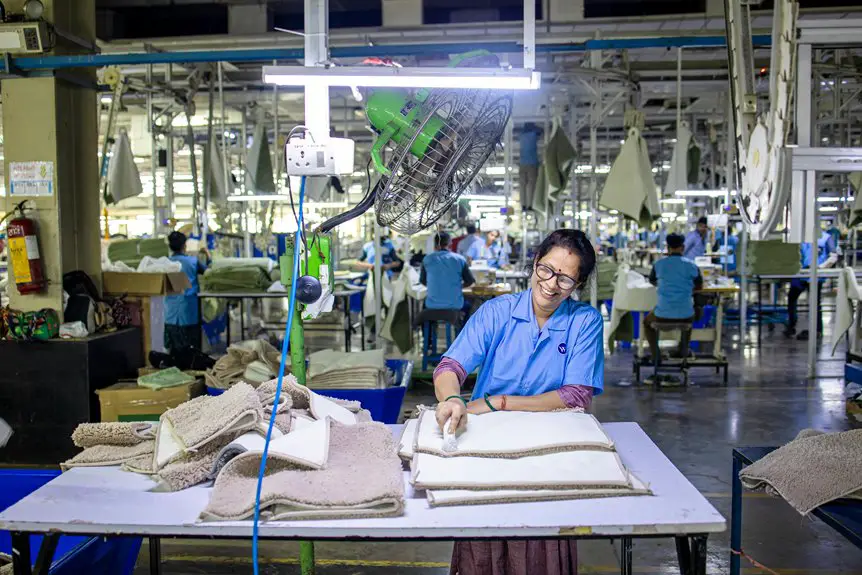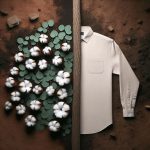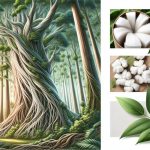You might not realize how much your clothing affects both your comfort and the environment. Tencel, also known as Lyocell, offers a unique blend of moisture management and eco-conscious production that sets it apart from other fabrics. Its ability to wick sweat efficiently while being gentle on your skin is impressive, but there’s more to uncover about how it’s made and why it’s considered a sustainable choice. Let’s explore what makes Tencel/Lyocell stand out.
Table of Contents
Key Takeaways
- Tencel/Lyocell excels at moisture-wicking by absorbing sweat and allowing air circulation, keeping skin dry and comfortable.
- Its closed-loop production recycles over 99% of solvents, drastically reducing pollution and resource consumption.
- The fabric’s water footprint is only 250 liters per kg, far lower than cotton’s 10,000 liters per kg.
- Made from sustainably managed forests, Tencel/Lyocell supports biodiversity and minimizes environmental impact.
- Hypoallergenic and breathable, it promotes skin health by reducing irritation and friction for sensitive skin types.
Understanding the Moisture-Wicking Properties of Tencel/Lyocell
Although you mightn’t realize it, the moisture-wicking abilities of Tencel/Lyocell make it a standout fabric for comfort.
When you wear garments made from this fiber, its excellent moisture absorption keeps sweat away from your skin, helping you feel dry and fresh throughout the day.
This fabric breathability allows air to circulate freely, preventing overheating even during physical activities.
Unlike some synthetic materials that trap moisture, Tencel/Lyocell fibers pull water vapor away efficiently, enhancing your overall comfort.
So, whether you’re exercising or just going about your daily routine, this fabric lets your skin breathe while managing moisture effectively.
Choosing Tencel/Lyocell means you don’t have to compromise on comfort, thanks to its natural ability to wick moisture and promote ventilation.
Environmental Benefits of Using Tencel/Lyocell Fibers
Because Tencel/Lyocell fibers come from sustainably managed forests and use a closed-loop production process, they offer considerable environmental benefits.
When you choose Tencel/Lyocell, you’re supporting materials that break down naturally, providing biodegradable benefits that reduce landfill waste. This means less environmental pollution compared to synthetic fibers.
Additionally, Tencel/Lyocell production considerably lowers its carbon footprint by recycling nearly all solvents and minimizing harmful emissions.
You’ll also appreciate that the sustainable sourcing practices help preserve biodiversity and forest health.
By opting for Tencel/Lyocell fibers, you actively reduce your environmental impact without sacrificing fabric quality.
These fibers combine eco-friendly production with excellent performance, making them a smart choice for anyone who cares about sustainability and the planet.
Comparing Water Usage: Tencel/Lyocell vs. Traditional Fabrics
Beyond their sustainable sourcing and biodegradability, Tencel/Lyocell fibers also stand out for their efficient water use. When you compare their water footprint with traditional fabrics, you’ll see a significant difference. Tencel/Lyocell requires far less water during production, helping reduce environmental strain. Here’s a quick fabric comparison to illustrate:
| Fabric Type | Water Footprint (liters per kg) |
|---|---|
| Tencel/Lyocell | 250 |
| Cotton | 10,000 |
| Polyester | 70 |
| Wool | 5,000 |
Choosing Tencel/Lyocell means you’re opting for a fabric that demands considerably less water, supporting sustainable textile choices without compromising quality.
The Closed-Loop Production Process and Its Impact on Sustainability
When you choose Tencel/Lyocell, you’re supporting a closed-loop production process that drastically reduces waste and environmental impact.
This system recycles and reuses the solvents involved in turning wood pulp into fabric, capturing over 99% of them for continuous use.
The closed loop benefits go beyond reducing pollution; they also minimize water and energy consumption, making sustainable production truly attainable.
Unlike conventional textile manufacturing, which often releases harmful chemicals, the Tencel/Lyocell process protects ecosystems and workers alike.
By opting for this fabric, you contribute to a cleaner, greener industry that prioritizes resource efficiency.
This innovative approach guarantees that sustainability isn’t just a buzzword but a practical reality embedded in every fiber you wear.
How Tencel/Lyocell Enhances Comfort and Skin Health
Although you might not always notice, the fabric you wear plays an essential role in your comfort and skin health. Tencel/Lyocell is a breathable fabric that helps regulate moisture, keeping your skin dry and reducing the risk of skin irritation. Its smooth fibers feel gentle against your skin, making it ideal if you’re prone to sensitivity.
| Feature | Benefit |
|---|---|
| Breathable fabric | Promotes airflow, reduces sweat buildup |
| Moisture-wicking | Keeps skin dry, prevents irritation |
| Smooth fibers | Minimizes friction, soothes sensitive skin |
| Hypoallergenic | Suitable for sensitive skin types |
Choosing Tencel/Lyocell means you’re investing in comfort that supports healthier skin every day.
Frequently Asked Questions
Can Tencel/Lyocell Fabrics Be Dyed Easily Without Damaging Fibers?
Dyeing delicate Tencel demands diligence. You’ll find it boasts brilliant dye absorption and strong colorfast properties, so you can confidently color your clothes without fearing fiber damage or fading. Just handle them with care!
How Does Tencel/Lyocell Compare in Cost to Other Sustainable Fabrics?
You’ll find Tencel pricing slightly higher than some sustainable alternatives like organic cotton, but its eco-friendly production justifies the cost. Choosing Tencel supports sustainability without compromising quality or durability in your fabrics.
Are Tencel/Lyocell Garments Suitable for Machine Drying?
Like walking on thin ice, machine drying Tencel/Lyocell can damage its fibers. You’ll want to choose gentle drying methods, like air-drying, to preserve fabric care and keep your garments looking fresh and lasting longer.
What Types of Clothing Are Best Made From Tencel/Lyocell?
You’ll find Tencel/Lyocell perfect for activewear thanks to its moisture-wicking benefits and breathability. It’s also great for casual wear, offering softness and durability that keep you comfortable all day long.
Does Tencel/Lyocell Fabric Resist Pilling Over Time?
Imagine your favorite sweater after countless washes, still smooth and soft—that’s Tencel’s pilling resistance in action. You’ll appreciate its fabric durability, as it holds up well over time, resisting those pesky pills that ruin looks.
- The Use of Nonwovens in Construction and Civil Engineering - July 11, 2025
- The Use of Nonwovens in Construction and Civil Engineering - July 11, 2025
- The Use of Nonwovens in Construction and Civil Engineering - July 11, 2025







